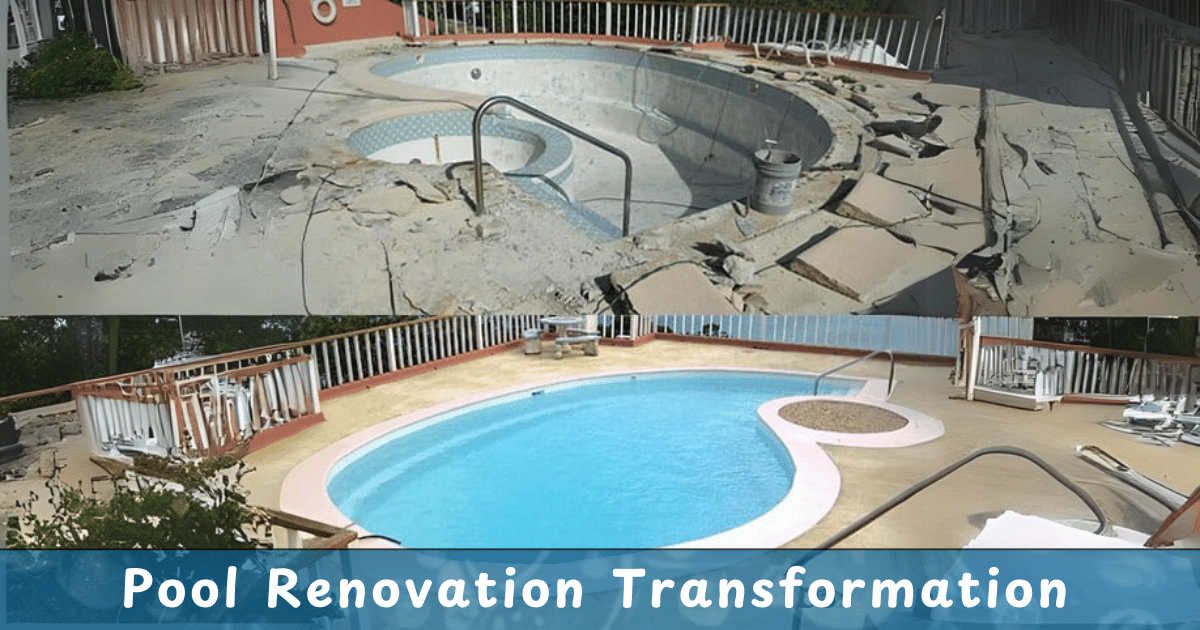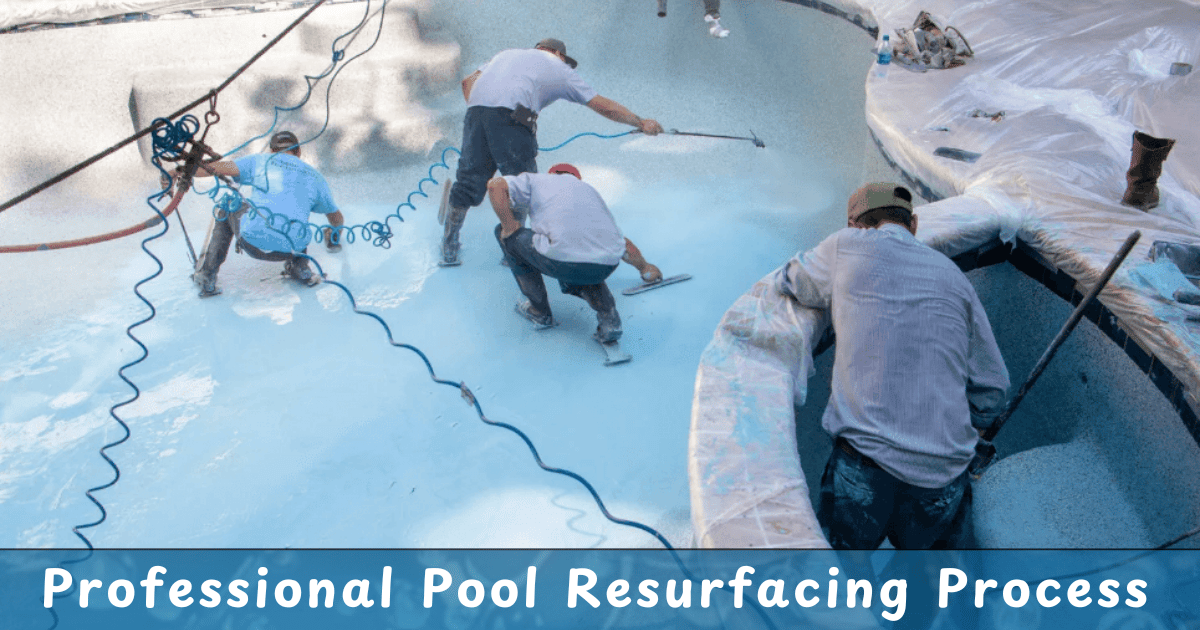A well-done resurfacing project can completely transform your backyard oasis. Resurfacing isn’t just for aesthetics; it’s essential for maintaining pool safety and extending its lifespan. The cost of resurfacing a pool typically ranges from $4,000 to $15,000, depending on pool size and chosen materials. This range may seem broad, but this guide will help you navigate through options to find the best solution for your specific needs and budget.
The Basics of Swimming Pool Resurfacing Costs
Understanding the fundamentals of swimming pool resurfacing costs will help you create an appropriate budget for your renovation project. For a standard 1,000 square foot pool, costs typically range between $6,000 and $11,000. Various factors affect this range, including your pool’s size, selected materials, and geographic location.

Concrete pools generally cost around $6,500 per 1,000 square feet to resurface. This investment enhances both appearance and functionality. Concrete offers durability and classic aesthetics but requires regular maintenance to maintain optimal condition.
Fiberglass resurfacing represents a higher initial investment, ranging from $16,000 to $26,000. However, fiberglass is popular for its longevity and superior surface quality, which often translates to reduced long-term maintenance costs.
Cost Breakdown by Pool Type and Material
Resurfacing costs vary significantly based on pool type and materials used:
Concrete Pools
Concrete pools command higher prices but offer excellent durability and customization options. Resurfacing a concrete pool typically costs between $10,000 and $15,000. This process involves removing the old finish, addressing necessary repairs, and applying a new plaster coating.
Fiberglass Pools
Fiberglass pool resurfacing is generally more affordable than concrete. Because these pools feature a single-piece pre-formed shell, they’re less susceptible to the deterioration that affects concrete pools. Resurfacing a fiberglass pool costs approximately $4,500 to $6,500, which includes cleaning the shell and applying a new gel coat to restore its appearance.
Both options enhance longevity and aesthetics, maximizing your investment in your backyard retreat. Whether you choose fiberglass or concrete, quality resurfacing will yield cost savings over time and provide many additional years of swimming enjoyment.
Factors Influencing the Cost of Pool Resurfacing
Several key factors affect the final cost of your pool resurfacing project:
Geographic Location
Your location significantly impacts pricing. Labor and material costs in regions like California may be substantially higher than in Texas or other areas with lower costs of living.
Material Selection
The materials you choose dramatically influence the total cost. Plaster remains a popular choice due to its affordability, typically costing less than more durable but expensive options like pebble or quartz finishes.
Pool Size
Size matters significantly in determining cost. Larger pools require more materials and labor, directly increasing the overall price.
Consider these factors carefully when planning your pool renovation to avoid unexpected expenses and make informed decisions that balance cost with longevity.
The Financial Implications of Pool Size and Shape
Understanding how pool size and shape affect resurfacing costs is crucial for budget planning. Larger pools and those with complex designs invariably cost more to resurface. Complex patterns require additional labor and materials, increasing overall expenses.

For example, a kidney-shaped pool typically costs more to resurface than a rectangular one because the curves require more intricate work. A standard rectangular pool might cost approximately $5,000 to resurface, but this price increases significantly with the addition of curves, steps, or unique architectural features.
To manage costs effectively, consider how a simpler design that’s easier to maintain and repair might benefit you in the long term. Finding the right balance between aesthetic appeal and maintenance requirements is key to maximizing your pool investment.
Choosing the Right Material for Your Pool
Selecting the appropriate material for your pool resurfacing project involves considering aesthetics, durability, and maintenance requirements:
Plaster
The most common and affordable option, plaster typically requires refinishing every 5-10 years. It provides a smooth texture and is relatively easy to maintain.
Pebble Finishes
Excellent for durability and natural appearance, pebble finishes last 15-20 years. While more expensive than plaster, they resist algae growth and staining, making them a valuable long-term investment.
Fiberglass
Ideal for those seeking a low-maintenance option, fiberglass offers aesthetic appeal, requires fewer chemicals, and can last over 25 years.
Each material offers distinct advantages and limitations. Consider what matters most for your pool experience, whether it’s initial cost, longevity, or ease of maintenance.
Additional Costs to Consider
When budgeting for pool resurfacing, remember to account for supplementary expenses that can quickly accumulate:
Water Removal and Replacement
You’ll need to drain, clean, and refill your pool. These costs vary significantly based on your pool size and local water rates. Many homeowners overlook this expense in their initial budget calculations while resurfacing their pool.
Unexpected Repairs
During resurfacing, contractors may discover hidden issues like cracks or leaks beneath the old surface. Addressing these problems promptly prevents further deterioration and additional expenses later.
Optional Enhancements
Consider whether you want to incorporate upgrades like new tiling or energy-efficient equipment. These improvements enhance appearance and functionality but will increase your total investment.
To avoid budget surprises, include these considerations in your initial planning. Remember that investing appropriately now can prevent costly repairs in the future.
DIY vs. Professional Pool Resurfacing
When considering pool resurfacing, choosing between DIY and professional services depends on several factors, with cost and quality being paramount.

Professional resurfacing typically costs between $4,000 and $7,000, depending on pool size and materials like plaster, pebble, or fiberglass. DIY materials might only cost $2,000 to $3,000, representing significant upfront savings.
However, the true value of professional resurfacing lies in its long-term benefits. Professionals deliver greater precision and use higher-quality materials, resulting in finishes that can last up to 15 years, compared to approximately 5 years for many DIY applications.
DIY resurfacing requires substantial knowledge of basic construction principles and familiarity with specialized tools. While the initial cost savings may be tempting, substandard application can lead to greater expenses over time.
Most pool owners find professional services worth the investment for their longevity, warranty coverage, and peace of mind.
Long-term Savings from Pool Resurfacing
Resurfacing your pool isn’t merely an aesthetic improvement; it’s a sound financial decision that generates long-term savings. By incorporating modern energy-efficient materials, you can substantially reduce maintenance costs over time.
High-quality alternatives to plaster, such as pebble or fiberglass, offer extended durability and better resistance to algae growth, reducing chemical usage and cleaning frequency. Adding energy-saving features like LED pool lighting and variable-speed pumps during the resurfacing process can reduce energy costs by up to 90%.
The reduced utility bills will offset the initial investment over several years. Consider this process an investment in your property that enhances both swimming experience and operational efficiency. Making these upgrades during resurfacing represents a financially prudent decision with substantial long-term benefits.
Conclusion
Pool resurfacing significantly enhances both appearance and functionality. Whether you select plaster, pebble, or fiberglass, the right material will improve aesthetics while extending the pool’s lifespan and overall safety. While costs vary based on size, material, and location, the additional years of enjoyment and reduced maintenance expenses make resurfacing a worthwhile investment.
Choose quality materials and consider incorporating energy-efficient upgrades during the resurfacing process to minimize future repair and utility costs. Resurfacing your pool today will enhance its appearance, extend its lifespan, and reduce long-term expenses—making your pool the highlight of your summer season for years to come.
Frequently Asked Questions (FAQs)
1. Is it worth resurfacing a pool?
Yes, resurfacing a pool is worthwhile as it extends its lifespan, enhances safety, and improves overall aesthetics.
2. How often should a swimming pool be resurfaced?
Swimming pools generally need resurfacing every 10 to 15 years, depending on usage and maintenance practices.
3. What is the best type of pool resurfacing?
Pebble finishes are highly recommended for their longevity and attractive appearance, though choices vary based on budget and preference.
4. How much does it cost to resurface concrete around a pool?
The cost typically ranges from $5 to $10 per square foot, influenced by the area size and chosen materials.






